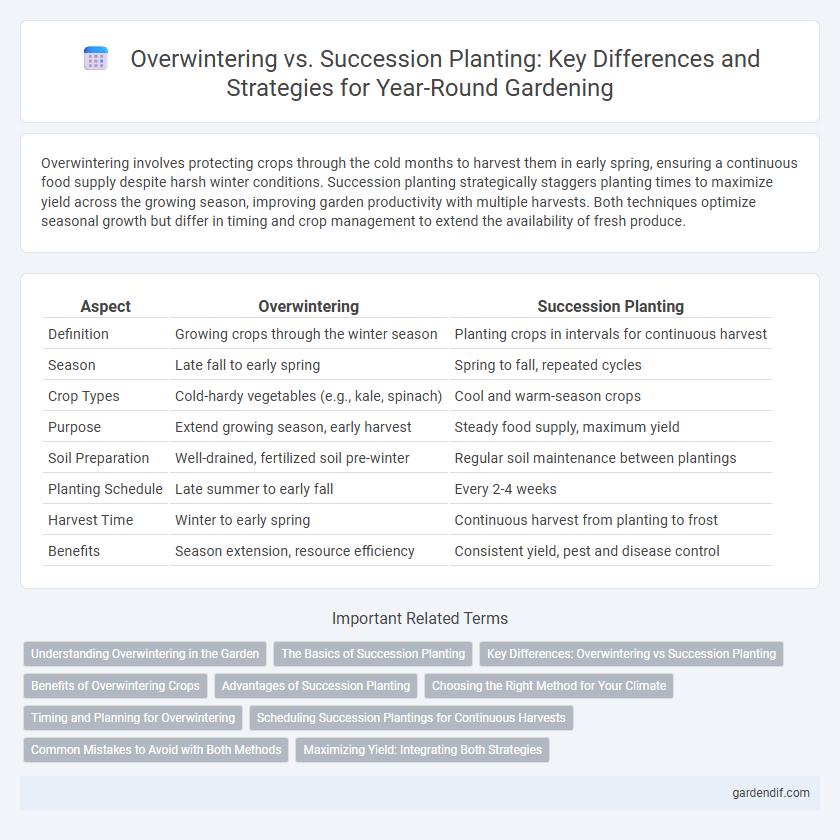
Overwintering vs Succession planting Illustration
Overwintering involves protecting crops through the cold months to harvest them in early spring, ensuring a continuous food supply despite harsh winter conditions. Succession planting strategically staggers planting times to maximize yield across the growing season, improving garden productivity with multiple harvests. Both techniques optimize seasonal growth but differ in timing and crop management to extend the availability of fresh produce.
Table of Comparison
| Aspect | Overwintering | Succession Planting |
|---|---|---|
| Definition | Growing crops through the winter season | Planting crops in intervals for continuous harvest |
| Season | Late fall to early spring | Spring to fall, repeated cycles |
| Crop Types | Cold-hardy vegetables (e.g., kale, spinach) | Cool and warm-season crops |
| Purpose | Extend growing season, early harvest | Steady food supply, maximum yield |
| Soil Preparation | Well-drained, fertilized soil pre-winter | Regular soil maintenance between plantings |
| Planting Schedule | Late summer to early fall | Every 2-4 weeks |
| Harvest Time | Winter to early spring | Continuous harvest from planting to frost |
| Benefits | Season extension, resource efficiency | Consistent yield, pest and disease control |
Understanding Overwintering in the Garden
Overwintering in the garden involves protecting plants to survive the cold winter months, often by using mulch, cloches, or cold frames to maintain soil temperature and moisture. This technique ensures perennial plants or biennials continue growth or remain viable for the next season, reducing the need to replant. Understanding overwintering allows gardeners to extend their growing season and improve crop yields by preserving valuable plants through colder periods.
The Basics of Succession Planting
Succession planting involves strategically timing seed sowing to ensure continuous harvest throughout the growing season, maximizing garden productivity. This method contrasts with overwintering, where crops are planted to survive and grow through the winter months. By staggering planting schedules for crops like lettuce, carrots, and radishes, gardeners can consistently enjoy fresh produce without gaps in supply.
Key Differences: Overwintering vs Succession Planting
Overwintering involves protecting and sustaining crops through the cold season to extend their growth cycle, while succession planting entails staggered sowing to ensure continuous harvests throughout the season. Key differences include timing; overwintering starts before winter with hardy varieties, whereas succession planting occurs throughout the growing season with regular intervals. Overwintering maximizes long-term yield from the same plants, and succession planting optimizes space and harvest frequency by continuously planting new crops.
Benefits of Overwintering Crops
Overwintering crops enhance soil health by reducing erosion and increasing organic matter through natural mulch layers. They provide early spring yields, allowing gardeners to extend the growing season and secure fresh produce before traditional planting cycles begin. This method also minimizes weed growth and pest pressure by maintaining continuous ground cover during dormant periods.
Advantages of Succession Planting
Succession planting maximizes garden productivity by allowing continuous harvests throughout the growing season, reducing idle soil time and increasing crop yield. It enhances crop diversity, which can improve pest and disease management by disrupting pest habitats and breaking disease cycles. This method also adapts well to climate variability, enabling gardeners to adjust planting schedules based on seasonal changes and extend harvest periods effectively.
Choosing the Right Method for Your Climate
Overwintering suits regions with mild winters, enabling crops like kale and spinach to grow through dormancy, while succession planting benefits warmer climates by staggering sowing times for continuous harvests. Selecting the appropriate method depends on local frost dates, soil temperature, and crop tolerance to cold or heat stress. Understanding these climatic factors ensures optimized growth cycles and maximizes seasonal yields.
Timing and Planning for Overwintering
Overwintering requires careful timing and planning to protect plants from frost and sustain growth during colder months, often involving early planting of cold-hardy varieties before the first frost date. Succession planting, by contrast, focuses on staggered sowing throughout the growing season to ensure continuous harvests but does not typically prioritize cold weather survival. Precise timing for overwintering includes understanding local climate patterns and selecting appropriate crops like spinach, kale, or garlic that thrive in low temperatures.
Scheduling Succession Plantings for Continuous Harvests
Scheduling succession plantings involves strategically timing seed sowing to ensure continuous harvests throughout the growing season. By staggering crop varieties based on their maturation rates and climate requirements, gardeners can maximize yield and maintain consistent produce availability. Proper planning considers overwintering crops to fill seasonal gaps and extend the garden's productivity into colder months.
Common Mistakes to Avoid with Both Methods
Overwintering and succession planting often suffer from common mistakes such as poor timing and inadequate soil preparation, which can lead to stunted growth or crop failure. Failing to account for local climate conditions or plant hardiness zones frequently causes overwintering plants to freeze or succession crops to bolt prematurely. Neglecting proper spacing and irrigation further reduces yield and increases susceptibility to pests and diseases in both planting methods.
Maximizing Yield: Integrating Both Strategies
Maximizing yield involves integrating overwintering and succession planting by using cold-hardy crops to extend harvest periods through winter and planting follow-up crops at staggered intervals to ensure continuous production. Overwintering techniques, such as mulching and selecting frost-resistant varieties, protect plants and maintain soil health during colder months. Succession planting fills the gaps between overwintered crops, optimizing space and resources for a year-round productive garden.
Overwintering vs Succession planting Infographic

 gardendif.com
gardendif.com